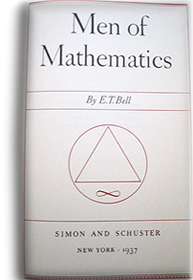Men of Mathematics
by Andrew Boyd
Today, fact or fiction? The University of Houston's College of Engineering presents this series about the machines that make our civilization run, and the people whose ingenuity created them.
His name was Eric Temple Bell. But his readers knew him as E. T. Bell. That's what appeared on his most famous book, Men of Mathematics, written in 1937.

I first met Bell's work as a college freshman when a professor lent me a copy. And it was a wonderful read. I learned that Évariste Galois'"magnificent powers [as a mathematician] were shattered before the mass stupidity aligned against him, and [that] he beat his life out fighting one unconquerable fool after another." I discovered that Carl Friedrich Gauss' father was "an upright, scrupulously honest man whose harshness sometimes … bordered on brutality." And Blaise Pascal was a "gifted mathematician who let his masochistic proclivities for self-torturing … degrade him [in]to … a religious neurotic." I met peasants, snobs, prima donnas, incorrigible speculators, charming friends, and crusty chemists. Together with Bell, I tussled with governments, rode tidal waves, and climbed lofty pyramids. Bell was a storyteller.
And that's what got him into trouble. Here's another passage from the chapter on Galois.
All night long [Galois]… spent the fleeting hours [before the morning's duel] feverishly dashing off his scientific last will and testament, writing against time to glean a few of the great things in his teeming mind before the death which he saw could overtake him. Time after time he broke off to scribble in the margin, "I have not time; I have not time," and passed on to the next frantically scrawled outline. What he wrote in those last desperate hours before the dawn will keep generations of mathematicians busy for hundreds of years. He had found, once and for all, the true solution of a riddle which had tormented mathematicians for centuries.
Now, there's nothing fundamentally wrong with Bell's account— although Galois wrote "I have not time" in the margin only once. And Galois hadn't solved anything that night. He'd been working on the problem for years. With death potentially looming, it just seemed like a good time to get things on paper. And that's why the book Men of Mathematics has been criticized. Bell over romanticized. He was a mathematician and scholar, not a Hollywood screen writer. He put forth Men of Mathematics as history.
In an award winning critique, Princeton physicist and author Tony Rothman writes that Bell's "… chronology is rearranged, events are omitted, and others invented in increasing quantity, until the end of his account is largely fantasy." The respected mathematical historian Ivor Grattan-Guinness simply refers to Men of Mathematics as "unscholarly".
So Bell came up short writing history. But we mustn't judge him too harshly. Men of Mathematics blends great concepts in mathematics with stories about the people behind them. It veers from documentary toward docudrama. But taken with a grain of salt, it's still a treat to read.
I'm Andy Boyd at the University of Houston, where we're interested in the way inventive minds work.
E. T. Bell. Men of Mathematics. (New York: Simon & Schuster, 1937).
Ivor Grattan-Guinness. 1971. "Towards a biography of Georg Cantor," Annals of Science 27: 345-91.
Tony Rothman. 1982. "Genius and biographers: The fictionalization of Évariste Galois," American Mathematical Monthly 89(2): 84-106.